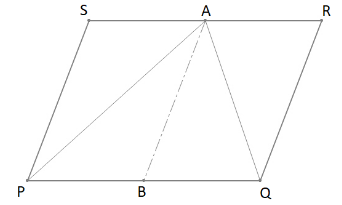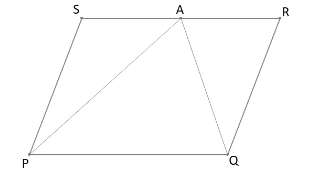Answer
424.5k+ views
Hint: Draw the figure after understanding the question’s need. Make a line segment from point A to midpoint of the opposite side. This will divide the field in two parallelograms and four triangles. Now try to establish a relationship between these areas.
Complete step-by-step answer:
Here in the figure, we can see that A is joined to two vertices of the parallelogram, dividing the field into three parts.
The field is divided into three triangles, i.e.$\Delta PSA$ ,$\Delta PAQ$and$\Delta QAR$.
Now for the second part of the question, we have three different crops which should be sown in three different parts of the field according to the relation given in the question.
So, we need to deduce a relation between these three areas of the triangular parts.

For making things more understandable, imagine a line segment $\overline {AB} $ joining midpoint of $\overline {PQ} $ and point A.
Since $\overline {AB} $ is bisecting $\overline {SR} $ and$\overline {PQ} $ , which are transversal to parallel lines $\overline {PS} $ and $\overline {RQ} $
Therefore, $AB\parallel PS$ and $AB\parallel RQ$and we get two new parallelograms PSAB and QRAB
Considering parallelogram PSAB by using the theorem that states “A diagonal of a parallelogram always divides it into two congruent triangles” and since congruent triangles always have equal areas, we can conclude that:
$\Delta PSA \cong \Delta PBA \Rightarrow Area\Delta PSA = Area\Delta PBA$ (1)
Similarly, if we use the above theorem for parallelogram QRAB, we can say that:
$\Delta QAR \cong \Delta QAB \Rightarrow Area\Delta QAR = Area\Delta QAB$ (2)
Let’s now add up these two relations (1) and (2)
$Area\Delta PSA + Area\Delta QAR = Area\Delta PBA + Area\Delta QAB$
But from our figure, we know that $\Delta PBA + \Delta QAB = \Delta PAQ$, which implies that:
$Area\Delta PSA + Area\Delta QAR = Area\Delta PAQ$
This gives us a direct relationship between the three parts of the field. And now farmers can sow paddy and pulses in the two smaller triangular parts $\Delta PSA$ & $\Delta QAR$ and groundnuts in the bigger triangular part $\Delta PAQ$.
Note: In geometry, always draw a figure using the information given in the question. Do not assume anything unless it is given in the question itself. Use the fundamental theorems associated with the geometry you are dealing with. The alternative approach to this problem can be using the theorem “A diagonal of a parallelogram divides it into two equal areas”.
Complete step-by-step answer:
Here in the figure, we can see that A is joined to two vertices of the parallelogram, dividing the field into three parts.
The field is divided into three triangles, i.e.$\Delta PSA$ ,$\Delta PAQ$and$\Delta QAR$.
Now for the second part of the question, we have three different crops which should be sown in three different parts of the field according to the relation given in the question.
So, we need to deduce a relation between these three areas of the triangular parts.

For making things more understandable, imagine a line segment $\overline {AB} $ joining midpoint of $\overline {PQ} $ and point A.
Since $\overline {AB} $ is bisecting $\overline {SR} $ and$\overline {PQ} $ , which are transversal to parallel lines $\overline {PS} $ and $\overline {RQ} $
Therefore, $AB\parallel PS$ and $AB\parallel RQ$and we get two new parallelograms PSAB and QRAB
Considering parallelogram PSAB by using the theorem that states “A diagonal of a parallelogram always divides it into two congruent triangles” and since congruent triangles always have equal areas, we can conclude that:
$\Delta PSA \cong \Delta PBA \Rightarrow Area\Delta PSA = Area\Delta PBA$ (1)
Similarly, if we use the above theorem for parallelogram QRAB, we can say that:
$\Delta QAR \cong \Delta QAB \Rightarrow Area\Delta QAR = Area\Delta QAB$ (2)
Let’s now add up these two relations (1) and (2)
$Area\Delta PSA + Area\Delta QAR = Area\Delta PBA + Area\Delta QAB$
But from our figure, we know that $\Delta PBA + \Delta QAB = \Delta PAQ$, which implies that:
$Area\Delta PSA + Area\Delta QAR = Area\Delta PAQ$
This gives us a direct relationship between the three parts of the field. And now farmers can sow paddy and pulses in the two smaller triangular parts $\Delta PSA$ & $\Delta QAR$ and groundnuts in the bigger triangular part $\Delta PAQ$.
Note: In geometry, always draw a figure using the information given in the question. Do not assume anything unless it is given in the question itself. Use the fundamental theorems associated with the geometry you are dealing with. The alternative approach to this problem can be using the theorem “A diagonal of a parallelogram divides it into two equal areas”.
Recently Updated Pages
How many sigma and pi bonds are present in HCequiv class 11 chemistry CBSE

Why Are Noble Gases NonReactive class 11 chemistry CBSE

Let X and Y be the sets of all positive divisors of class 11 maths CBSE

Let x and y be 2 real numbers which satisfy the equations class 11 maths CBSE

Let x 4log 2sqrt 9k 1 + 7 and y dfrac132log 2sqrt5 class 11 maths CBSE

Let x22ax+b20 and x22bx+a20 be two equations Then the class 11 maths CBSE

Trending doubts
Fill the blanks with the suitable prepositions 1 The class 9 english CBSE

At which age domestication of animals started A Neolithic class 11 social science CBSE

Which are the Top 10 Largest Countries of the World?

Give 10 examples for herbs , shrubs , climbers , creepers

Difference between Prokaryotic cell and Eukaryotic class 11 biology CBSE

Difference Between Plant Cell and Animal Cell

Write a letter to the principal requesting him to grant class 10 english CBSE

Change the following sentences into negative and interrogative class 10 english CBSE

Fill in the blanks A 1 lakh ten thousand B 1 million class 9 maths CBSE




